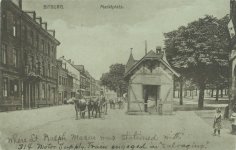I find the history of an item fascinating, especially when it has a unit identification and the former owner’s name. In the case of this pickelhaube, it was in the inventory of the Train Battalion No 8, aka “Rheinisches Train-Bataillon Nr. 8”. Based on writing inside it, one learns that it became a Doughboys property during the AEF move into occupied Germany on 2 December 1918.
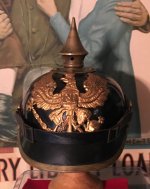
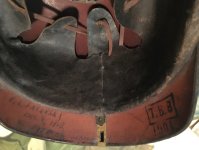
The pickelhaube, an M-1895 OR Prussian Pickelhaube, is in excellent condition. The rear visor left side has a rectangular stamp with the initials T. B. 8 with an additional stamp 1904; this signifies that the Prussian Army’s 8th Train Battalion had this helmet on its account in 1904. For a leather helmet that is 117 years old, except for mildew spots on the shell interior and the liner, the pickelhaube had seen little use. Written in ink on the right side of the rear visor helmet are three lines:
E. L. FALEVSKY
DEC 2 1918
BITBURG GERMANY
For me, this purchase was exciting because all this indicated that the pickelhaube was a trophy brought back by a doughboy sometime after the Armistice, most likely in the year 1919. So I used ancestry.com’s “U.S., Army Transport Service Arriving and Departing Passenger Lists, 1910-1939” search engine and put in the Name: E. L. FALEVSKY and the arrival date of 1919 Hoboken, New Jersey and found the following:
Name: Edward L. C. Falevsky
Departure Date: 15 May 1919
Departure Place: Brest, France
Arrival Date: 22 May 1919
Arrival Place: Hoboken, New Jersey
Residence Place: West De Pere, Wisconsin
Father: Henry Falevsky
Ship: Imperator
Military Unit: M. G. CO 125TH INF
Rank: Second Lieutenant
The 125th Infantry Regiment was a unit that was part of the 32D Division AEF, a National Guard Division during the First World War that was manned primarily with National Guard units from Michigan and Wisconsin. A quick check of period Division History and Welcome Home packet confirms that the elements of the 32D Division moved through Bitburg and that Bitburg is not far from Koblenz, Germany, where the Ehrenbreitstein Fortress and the home of the “Rheinisches Train-Bataillon Nr. 8” was stationed.
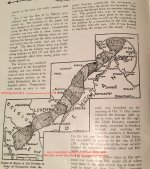
Here are some more pictures
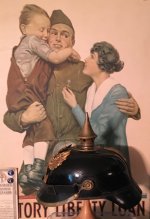
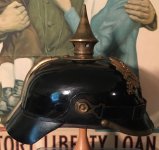
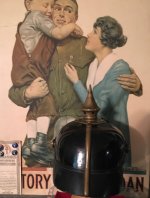
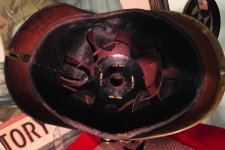
So, all the information validates what markings on the back visor of the pickelhaube. I hope everyone enjoyed the story of how this Prussian leather helmet found its way across the Atlantic.
Best regards,
John


The pickelhaube, an M-1895 OR Prussian Pickelhaube, is in excellent condition. The rear visor left side has a rectangular stamp with the initials T. B. 8 with an additional stamp 1904; this signifies that the Prussian Army’s 8th Train Battalion had this helmet on its account in 1904. For a leather helmet that is 117 years old, except for mildew spots on the shell interior and the liner, the pickelhaube had seen little use. Written in ink on the right side of the rear visor helmet are three lines:
E. L. FALEVSKY
DEC 2 1918
BITBURG GERMANY
For me, this purchase was exciting because all this indicated that the pickelhaube was a trophy brought back by a doughboy sometime after the Armistice, most likely in the year 1919. So I used ancestry.com’s “U.S., Army Transport Service Arriving and Departing Passenger Lists, 1910-1939” search engine and put in the Name: E. L. FALEVSKY and the arrival date of 1919 Hoboken, New Jersey and found the following:
Name: Edward L. C. Falevsky
Departure Date: 15 May 1919
Departure Place: Brest, France
Arrival Date: 22 May 1919
Arrival Place: Hoboken, New Jersey
Residence Place: West De Pere, Wisconsin
Father: Henry Falevsky
Ship: Imperator
Military Unit: M. G. CO 125TH INF
Rank: Second Lieutenant
The 125th Infantry Regiment was a unit that was part of the 32D Division AEF, a National Guard Division during the First World War that was manned primarily with National Guard units from Michigan and Wisconsin. A quick check of period Division History and Welcome Home packet confirms that the elements of the 32D Division moved through Bitburg and that Bitburg is not far from Koblenz, Germany, where the Ehrenbreitstein Fortress and the home of the “Rheinisches Train-Bataillon Nr. 8” was stationed.

Here are some more pictures




So, all the information validates what markings on the back visor of the pickelhaube. I hope everyone enjoyed the story of how this Prussian leather helmet found its way across the Atlantic.
Best regards,
John

